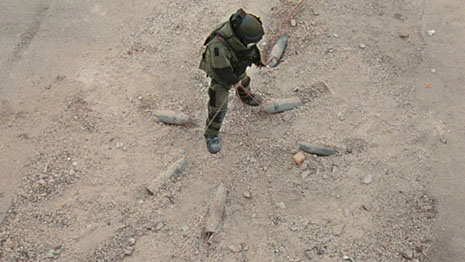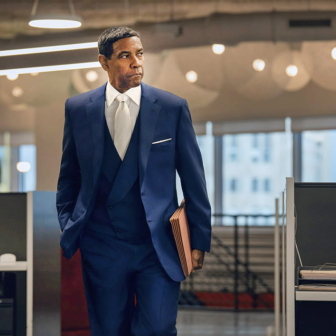SOME think The Hurt Locker, which seems to be doing pretty fair business, is a great contemporary war film, others think it isn’t a war film at all, and others again – generally vets, jumping in furiously on the online arguments – assume that it’s trying to be one, and should therefore have paid more attention to the details of uniforms and the behaviour of Humvee convoys in 2004, the ostensible date of the action. In fact, with all the gongs and Oscars, it’s not a great film, not even a very important one; there will be better ones to come on Iraq, and they probably need longer perspectives.
But Kathryn Bigelow’s essay does give us something to think about, our own viewing positions included. There is much argument and commentary from sources in the United States, from positions in which the catastrophic Iraq adventure can in some way be owned; it’s theirs. In Australia, the audience’s angle of vision is a bit more complicated; it relates to a reluctant, conflicted colonial position, one in which we were placed by a reactionary national leader who was determined to line up behind a foolish, gunhappy American one. If the story wasn’t really one of ours, it was thrust upon us. The Hurt Locker proposes that when it came down to individuals in the American ranks, they hadn’t much choice either; look, then, at three different ways of taking it personally.
Several serious critics have remarked on the film’s apparent refusal of politics; but the point of view has more to do with history. The material of the story is already four or five years in the past, and the framework is taken for granted. The audience is presumed to know that America’s purpose was to hunt out WMDs, and they weren’t there; the adventure was discredited long since, and Saddam is never mentioned. The film is about the total immersion of three ordinary soldiers in the sort of action for which they’ve been trained to the hilt; “boots on the ground.” There are bombs, and improvised explosive devices lying in rubble and in abandoned cars all over Baghdad; there are also suicide bombers, walking around in seeming innocence, and the man over there with the mobile phone is about to trigger the next massive explosion. Not even the appealing Iraqi urchin, jumping round the soldiers flogging DVDs, can be taken as innocent, although we never meet the mastermind who turned the twelve-year-old into another suicide bomber. The three we’re following belong to a unit charged with locating, dismantling, defusing and/or detonating, and otherwise trying to keep themselves and each other alive. They’re not asking why, and that, so far as there is one, is the central point.
The opening frames show a quoted phrase from a New York Times journalist, Chris Hedges, who said “war is a drug.” “Time to rock and roll,” the appalling phrase for lethal action, recurs. The audience is put into the position of the embedded journalist – and “embedding,” if you remember, was a tactic they thought up mainly to head off critical comment in the media; it wouldn’t do to let the journos choose their own vantage-points among enemies and victims. We’re at very close quarters with young Will James as he struggles to find, in time, the crucial connection in an endless tangle of wires in a loaded car. He manages it that time; later on he’ll fail, when the fuses are wrapped round the body of a desperate Iraqi who doesn’t want to die, and the bolt-cutters won’t do the job. In a more conventional treatment, we might talk about his and others’ growing up through their time in hell. But Bigelow and her writer Mark Boal, whose despatches from a truly embedded position made the film’s groundwork, are not offering the audience that sort of consolation; they pursue the workings of the drug, particularly on Will James. But it doesn’t work on everyone; his companions are the edgy Owen Eldridge (Brian Geraghty), pitiably ashamed of being scared, when he’s got everything to be scared of; and the wry Afro-American J.T. Sanborn, a marvellous performance by Anthony Mackie. J.T. is all too sane, and he hates the whole business.
Jeremy Renner creates Will as naive, young, strong, ready from the outset to pitch in, and as gifted as he’s crazy-brave. Heavily suited up and masked for the job, he becomes mythic, like a man walking on the moon. Will cares for his baby son, and shows his picture to the boys in the barracks, while letting them know that it was a shotgun wedding; the baby’s mother doesn’t really count with him. She is glimpsed taking a call from him in Iraq, but the line drops out; later, when he’s home again and they’re together in the supermarket, she asks him to pick up some cereal. There follows a shot straight out of J.-L. Godard at his most political: the alley in the supermarket is mind-numbing, endless, with a thousand varieties of breakfast food on show. Will re-enlists. The feminist perspective is briefly invited, then snapped off; as though the director had said: I know, but we’re not going there.
The life of the film is in the performances and in cinematic energy: action and bodily movement caught fast at close quarters (the director of photography was Barry Ackroyd) and brilliant highspeed editing (Bob Murawski and Chris Innis). A solid, fast movie thriller, with a proper quota of hair’s-breadth action and massive explosions, but history is named and can’t be evaded: what were they, what were we, ever doing there? If the film doesn’t put the question, the audience must. In the promotion material, Kathryn Bigelow speaks of “unsung heroes”; the unsung victims are literally out of the picture.
SYDNEY cinephiles can rejoice: in a restored print, Michael Powell and Emeric Pressburger’s magical The Red Shoes (1948) is running at the Chauvel, in delirious Technicolor, with the ultimate evil impresario (Anton Walbrook), and the beautiful dancer Victoria Page (Moira Shearer), doomed to choose between life and art. In the Hans Christian Andersen fairytale the red shoes had a demonic will of their own, and the dancer had no choice; in the highflown modern melodrama the choice is impossible, but only because the dancer’s masters – impresario and lover – make it so. This is a great renewed pleasure for some of us who saw it in distant schooldays; what can’t be retrieved is whatever, in those days, we might have thought it meant. •





